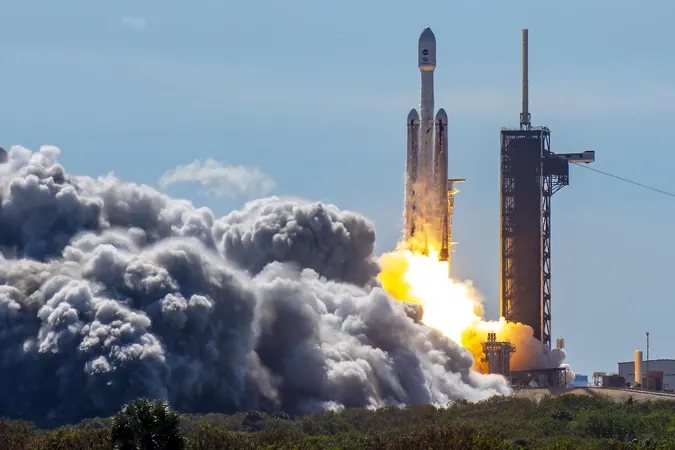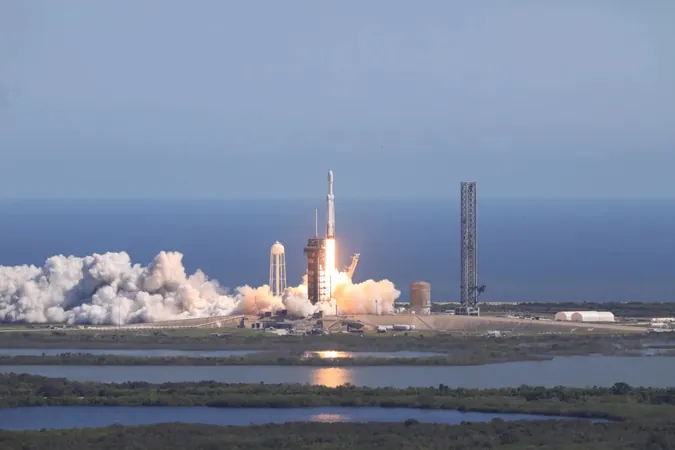
NASA Embarks on Groundbreaking Mission to Uncover Secrets of Europa, Jupiter's Mysterious Moon
2024-10-15
Author: Jia
NASA's ambitious Europa Clipper mission soars into the sky
NASA's ambitious Europa Clipper mission soared into the sky on Monday, marking a significant leap in humanity’s quest to explore the potential for extraterrestrial life. The spacecraft launched from Kennedy Space Center in Florida aboard a SpaceX Falcon Heavy rocket, representing a $5.2 billion investment in robotic exploration of one of the most intriguing locales in our Solar System.
Lift-off occurred at 12:06 PM EDT, following a short delay caused by Hurricane Milton, which swept through Central Florida just days before the launch. This marks the beginning of an incredible five-and-a-half-year odyssey to Jupiter, where Europa Clipper will orbit the giant planet and make numerous flybys of its icy moon, Europa.
Europa has captured the collective imagination of scientists for decades, with its surface encrusted in ice that likely conceals a vast ocean of liquid water underneath. Recent studies suggest this ocean may harbor the essential ingredients for life. "This is an epic mission," stated Curt Niebur, the program scientist for Europa Clipper at NASA. "We have the opportunity to explore a world that might still be habitable today.”
The fascination with Europa originated as far back as 1979 when NASA’s Voyager missions provided a first look at Jupiter and its moons. Subsequent missions, including the Galileo orbiter, reinforced the idea that beneath Europa's icy exterior lies a hidden ocean, raising tantalizing questions about the potential for life.
Despite initial hurdles—including budgetary constraints and political support—momentum surged when former Texas Congressman John Culberson championed the cause for a Europa mission. His advocacy helped secure funding and political backing from NASA and the Obama administration, leading to the mission's approval in 2015.
Fast-Paced Launch
After summer concerns regarding the resilience of the spacecraft's components in Jupiter's intense radiation environment, engineers confirmed that Europa Clipper was ready for its launch. With a weight of more than 12,500 pounds (5.7 metric tons) at launch, Europa Clipper stands as the largest spacecraft ever sent to another planetary body.
Fueled by the world’s most powerful operational rocket, the Falcon Heavy needed additional muscle to launch Europa Clipper towards its 1.8 billion-mile journey to Jupiter, which will include swing-bys of Mars and Earth to gain speed through gravitational assists. This mission is not only a technical feat but also one of NASA's most financially intense planetary science missions, costing about half as much as the groundbreaking James Webb Space Telescope.
Upon entering its trajectory, Europa Clipper will make its grand arrival at Jupiter on April 11, 2030, and initiate a series of 49 close encounters with Europa. "We will not attempt landing on Europa but will approach within 25 kilometers of its surface," explained Jordan Evans, the mission's project manager at NASA's Jet Propulsion Laboratory (JPL).
Unlocking the Mysteries Beneath the Ice
Unlike its predecessor, the Galileo spacecraft, which relied on 1980s technology, Europa Clipper is equipped with cutting-edge tools. The spacecraft carries nine state-of-the-art scientific instruments, including a powerful ice-penetrating radar that will search for liquid water beneath Europa's crust, high-resolution cameras for detailed imaging, and other sensors to analyze the moon’s composition and atmosphere.
The Hubble Space Telescope previously detected signs of water vapor plumes escaping from Europa’s surface, providing further support for the theory of a subsurface ocean. If Europa Clipper successfully navigates through one of these plumes, it could unlock unprecedented insights into the moon’s potential habitability.
Studies estimate that Europa's ocean may reach depths of 60 to 80 miles beneath the icy surface, while the ice shell itself could range from 10 to 20 miles thick. This subsurface environment may generate hydrothermal activity similar to what nourishes life deep in Earth’s oceans, opening up possibilities for similar ecosystems on Europa.
What Lies Ahead?
NASA hopes that Europa Clipper will reveal whether the moon has the conditions necessary for simple life. The mission aims to detect organic molecules and other chemical precursors to life, despite the challenges posed by Europa's harsh surface conditions, including exposure to radiation from Jupiter.
While direct evidence of life on Europa may require a future lander mission, the data collected by Europa Clipper will be invaluable in making that decision. As scientists sift through the anticipated deluge of information, they will focus on identifying regions of Europa that might be safe—and scientifically interesting—for a potential future landing.
According to Bob Pappalardo, the mission's project scientist at JPL, the ultimate goal is to find evidence of liquid water just below the moon’s surface. "That could be a game changer," he stated. “It might lead to a future mission where we can finally search for signs of life beneath Europa's mysterious icy exterior."
Overall, the Europa Clipper mission promises to be a landmark endeavor not only for NASA but also for the broader scientific community and humankind’s understanding of life's potential beyond Earth. The excitement is palpable as we collectively look forward to the groundbreaking discoveries this mission may unveil.



 Brasil (PT)
Brasil (PT)
 Canada (EN)
Canada (EN)
 Chile (ES)
Chile (ES)
 España (ES)
España (ES)
 France (FR)
France (FR)
 Hong Kong (EN)
Hong Kong (EN)
 Italia (IT)
Italia (IT)
 日本 (JA)
日本 (JA)
 Magyarország (HU)
Magyarország (HU)
 Norge (NO)
Norge (NO)
 Polska (PL)
Polska (PL)
 Schweiz (DE)
Schweiz (DE)
 Singapore (EN)
Singapore (EN)
 Sverige (SV)
Sverige (SV)
 Suomi (FI)
Suomi (FI)
 Türkiye (TR)
Türkiye (TR)